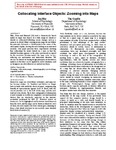Collocating Interface Objects: Zooming into Maps
| dc.contributor.author | May, Jon | |
| dc.contributor.author | Gamble, T | |
| dc.date.accessioned | 2014-09-19T12:48:52Z | |
| dc.date.available | 2014-09-19T12:48:52Z | |
| dc.date.issued | 2014-05-01 | |
| dc.identifier.isbn | 978-1-4503-2473-1 | |
| dc.identifier.uri | http://hdl.handle.net/10026.1/3115 | |
| dc.description.abstract |
May, Dean and Barnard [10] used a theoretically based model to argue that objects in a wide range of interfaces should be collocated following screen changes such as a zoom-in to detail. Many existing online maps do not follow this principle, but move a clicked point to the centre of the subsequent display, leaving the user looking at an unrelated location. This paper presents three experiments showing that collocating the point clicked on a map so that the detailed location appears in the place previously occupied by the overview location makes the map easier to use, reducing eye movements and interaction duration. We discuss the benefit of basing design principles on theoretical models so that they can be applied to novel situations, and so designers can infer when to use and not use them. | |
| dc.format.extent | 2085-2094 | |
| dc.language.iso | en | |
| dc.publisher | ACM | |
| dc.subject | cinematography | |
| dc.subject | cognitive models | |
| dc.subject | collocation | |
| dc.subject | eye-tracking | |
| dc.subject | maps | |
| dc.subject | zooming | |
| dc.title | Collocating Interface Objects: Zooming into Maps | |
| dc.type | conference | |
| dc.type | Conference Proceeding | |
| plymouth.author-url | https://www.webofscience.com/api/gateway?GWVersion=2&SrcApp=PARTNER_APP&SrcAuth=LinksAMR&KeyUT=WOS:000773858602019&DestLinkType=FullRecord&DestApp=ALL_WOS&UsrCustomerID=11bb513d99f797142bcfeffcc58ea008 | |
| plymouth.date-start | 2014-04-26 | |
| plymouth.date-finish | 2014-05-01 | |
| plymouth.publisher-url | http://www.acm.org/publications | |
| plymouth.conference-name | CHI 2014 | |
| plymouth.publication-status | Published | |
| plymouth.journal | CHI '14 Proceedings of the SIGCHI Conference on Human Factors in Computing Systems | |
| dc.identifier.doi | 10.1145/2556288.2557279 | |
| plymouth.organisational-group | /Plymouth | |
| plymouth.organisational-group | /Plymouth/Faculty of Health | |
| plymouth.organisational-group | /Plymouth/Faculty of Health/School of Psychology | |
| plymouth.organisational-group | /Plymouth/REF 2021 Researchers by UoA | |
| plymouth.organisational-group | /Plymouth/REF 2021 Researchers by UoA/UoA04 Psychology, Psychiatry and Neuroscience | |
| plymouth.organisational-group | /Plymouth/REF 2021 Researchers by UoA/UoA04 Psychology, Psychiatry and Neuroscience/UoA04 REF peer reviewers | |
| plymouth.organisational-group | /Plymouth/Research Groups | |
| plymouth.organisational-group | /Plymouth/Research Groups/Centre for Brain, Cognition and Behaviour (CBCB) | |
| plymouth.organisational-group | /Plymouth/Research Groups/Centre for Brain, Cognition and Behaviour (CBCB)/Behaviour | |
| plymouth.organisational-group | /Plymouth/Research Groups/Institute of Health and Community | |
| plymouth.organisational-group | /Plymouth/Users by role | |
| plymouth.organisational-group | /Plymouth/Users by role/Academics | |
| dc.publisher.place | Toronto, ON, Canada | |
| dc.publisher.place | New York, NY, US | |
| dc.rights.embargoperiod | Not known | |
| rioxxterms.versionofrecord | 10.1145/2556288.2557279 | |
| rioxxterms.licenseref.uri | http://www.rioxx.net/licenses/all-rights-reserved | |
| rioxxterms.type | Conference Paper/Proceeding/Abstract |


